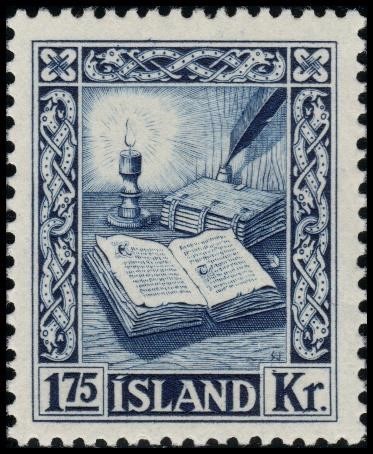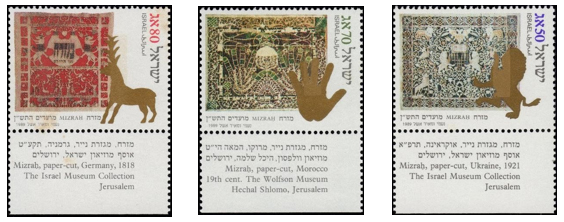With all the talk about the USPS, it got me thinking about mailing and stamps. In a recent move I uncovered my father’s boyhood stamp collection and in talking with local artist and collector, Mark Hoppmann, learned about his collection of stamps including those depicting books. Mark Hoppmann is an illustrator, painter, book artist, bibliophile, and collector of almost anything interesting. Working out of his studio in Tacoma, Washington, his work can be found in both private and public collections.
To learn more about the artist, visit his website, www.markhoppmannart.com
– Jane Carlin, Library Director
To the uninitiated, Philately is known as the study of postage stamps, postal history, and sometimes even the hobby of collecting stamps themselves, but not necessarily all three. Those who partake in any of the forementioned activities are known as Philatelists. Being a philatelist often involves peering through a loupe, detecting watermarks, counting the number of perforations, determining the color variety or even measuring the size of the stamp itself to determine which stamp you hold in your stamp tongs. But enough of schematics. Let’s talk about the art of the book…. on postage stamps. *
 It would have been fitting had the first image printed on a postage stamp been that of a book. Any book would do in the circumstances, but an image of the first book printed with movable type, the Gutenberg Bible, printed in turn on the first postage stamp would have been appropriate. Alas, it was not meant to be, although a stamp honoring Gutenberg was eventually issued in the United States over 110 years after the printing of the first postage stamp. Soon after Great Britain issued the first stamp known as the penny black in 1840, the rest of the world followed suit and unintentionally created the hobby of philately including an entire genre of stamp collecting known as head stamps. At least it can be said, Great Britain could claim that for the next 51 years they put a woman on theirs, but to be fair, there were other European nations that did as well. Not all stamps were “head stamps.” Some merely depicted the denomination of the stamp itself. Some were beautifully engraved while others border on being crude approximations of the engravers’ art often executed in far flung places with the tools at hand.
It would have been fitting had the first image printed on a postage stamp been that of a book. Any book would do in the circumstances, but an image of the first book printed with movable type, the Gutenberg Bible, printed in turn on the first postage stamp would have been appropriate. Alas, it was not meant to be, although a stamp honoring Gutenberg was eventually issued in the United States over 110 years after the printing of the first postage stamp. Soon after Great Britain issued the first stamp known as the penny black in 1840, the rest of the world followed suit and unintentionally created the hobby of philately including an entire genre of stamp collecting known as head stamps. At least it can be said, Great Britain could claim that for the next 51 years they put a woman on theirs, but to be fair, there were other European nations that did as well. Not all stamps were “head stamps.” Some merely depicted the denomination of the stamp itself. Some were beautifully engraved while others border on being crude approximations of the engravers’ art often executed in far flung places with the tools at hand.
Regardless of the subject matter, postage stamps were soon recognized by collectors as miniature works of art, even as the general populace saw the new contrivance as merely a necessary means of getting their mail to the intended destination. Nonetheless, It was evident that even head stamps, and eventually commemorative and pictorial stamps were mostly if not completely copied from paintings or even photographs and became exemplary of the engravers craft. It did not matter that postage stamps did not yet depict art of almost every form and from every culture of the world; They were artistic masterpieces in themselves. It became only fitting that one day, books would find their way onto postage stamps.

 When a book was first printed on a postage stamp, is hard to define. Often relegated to a supporting role, they first appeared as mere allegories such as the 1902 French issue depicting Marianne, the symbol of Republican France holding a tablet inscribed with “The Rights of Man,” which was the Constitution of the New Republic. Perhaps it was a world weary of war that turned its focus to depicting the worlds accomplishments on postage stamps. One of the earliest examples is that issued by the Russian Socialist Federated Soviet Republic, (PCФCP) in 1921, depicting allegories of “Science and Arts.” Italy also printed a set of stamps (not shown) in the same year, commemorating the 600th anniversary of The Divine Comedy and the death of Dante. A book or an allegory of a book is shown on each stamp.
When a book was first printed on a postage stamp, is hard to define. Often relegated to a supporting role, they first appeared as mere allegories such as the 1902 French issue depicting Marianne, the symbol of Republican France holding a tablet inscribed with “The Rights of Man,” which was the Constitution of the New Republic. Perhaps it was a world weary of war that turned its focus to depicting the worlds accomplishments on postage stamps. One of the earliest examples is that issued by the Russian Socialist Federated Soviet Republic, (PCФCP) in 1921, depicting allegories of “Science and Arts.” Italy also printed a set of stamps (not shown) in the same year, commemorating the 600th anniversary of The Divine Comedy and the death of Dante. A book or an allegory of a book is shown on each stamp.
 Not all countries were content with just depicting the book. In 1939, The United States printed a stamp, commemorating the Stephen Daye Press, the first printing press in Colonial America. Nearly 40 years later they followed up with the Bay Colony Psalms, the first book printed on the Stephen Daye press.
Not all countries were content with just depicting the book. In 1939, The United States printed a stamp, commemorating the Stephen Daye Press, the first printing press in Colonial America. Nearly 40 years later they followed up with the Bay Colony Psalms, the first book printed on the Stephen Daye press.
 On some stamps, the book was
On some stamps, the book was  not enough. They commemorate the author as well. In 1944, Ireland issued two postage stamps, one of which is shown on the left, and which commemorated the tercentenary of the death of Michael 0’Clery, Irish historian. The stamp depicts the friar hunched over his bench working on a book. In 1952, Iceland issued a set of five stamps honoring its literary heritage.
not enough. They commemorate the author as well. In 1944, Ireland issued two postage stamps, one of which is shown on the left, and which commemorated the tercentenary of the death of Michael 0’Clery, Irish historian. The stamp depicts the friar hunched over his bench working on a book. In 1952, Iceland issued a set of five stamps honoring its literary heritage.
 The 1945 stamp from Uruguay, honors the author José Pedro Varela, while in 1959, the Soviet Union honored the 700th anniversary of the book “Gulistan,” written in 1258 by the Persian Poet, Saadi Muslah-ud-Din. Over the course of the 20th century, many other countries including, Hungary, Greece, Uruguay, Israel, Canada, Iceland, and China to name only a few, have issued postage stamps commemorating a book, its printing or sometimes the printers themselves.
The 1945 stamp from Uruguay, honors the author José Pedro Varela, while in 1959, the Soviet Union honored the 700th anniversary of the book “Gulistan,” written in 1258 by the Persian Poet, Saadi Muslah-ud-Din. Over the course of the 20th century, many other countries including, Hungary, Greece, Uruguay, Israel, Canada, Iceland, and China to name only a few, have issued postage stamps commemorating a book, its printing or sometimes the printers themselves.
 Greece issued a stamp in 1976 celebrating a grammar book, the Grammatica Graeca, printed by Constantin Lascaris in Milan, Italy. This is known to be the first book printed entirely in the Greek alphabet.
Greece issued a stamp in 1976 celebrating a grammar book, the Grammatica Graeca, printed by Constantin Lascaris in Milan, Italy. This is known to be the first book printed entirely in the Greek alphabet.
In 2003, Hungary and China issued a joint pair of stamps. One stamp shows the Song dynasty edition of the Zhou Ritual, while the other is a Hungarian illuminated Chronicle, the first book printed in Hungary and published in 1473.
There are probably as many stamps celebrating the craft of printing as there are of the craft of book making. In 1952 the United States finally gave Johannes Gutenberg his due, and two years later, Germany followed suit with an issue of their own, although we should mention that Germany had honored him previously in 1940. And in 1973, Hungary issued a pair of stamps commemorating the printing of Orbis Pictus by Comenius, and the 500th Anniversary of the Hungarian translation of the Gospels. (not pictured)
Mizrah paper cuts from the Jewish Museum Collection, Jerusalem
Pages from a Jewish Mahzor, Worms, Germany: National University Library, Jerusalem
 By now the flood gates have opened. The genre of books on stamps can be divided into almost infinite sub-genre within sub-genre. Authors, printers, printing presses, printing processes, type design, alphabets, poets, manuscripts, prayer books, paper cutting, libraries, librarians; the list is limited only by our imaginations. Stamps depicting or commemorating Mayan codices, Cuneiform tablets, illuminated manuscripts, Incunabula, Jewish Torah scrolls, cylinder seals, hieroglyphic texts on parchment, and almost every book form imaginable can be found from almost every country in the world. All that is left to ponder is the book maker and their craft.
By now the flood gates have opened. The genre of books on stamps can be divided into almost infinite sub-genre within sub-genre. Authors, printers, printing presses, printing processes, type design, alphabets, poets, manuscripts, prayer books, paper cutting, libraries, librarians; the list is limited only by our imaginations. Stamps depicting or commemorating Mayan codices, Cuneiform tablets, illuminated manuscripts, Incunabula, Jewish Torah scrolls, cylinder seals, hieroglyphic texts on parchment, and almost every book form imaginable can be found from almost every country in the world. All that is left to ponder is the book maker and their craft.
*The postage stamps pictured in the above article were scanned from the author’s private collection. The Scott Standard Postage Stamp Catalog was used for reference only where the stamp did not have the issue date or the subject matter needed literal translation.




